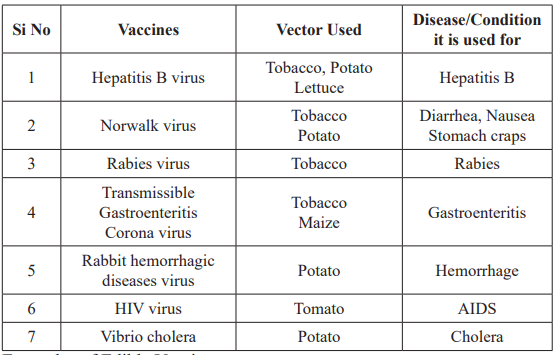Travel & Edible Vaccines
Author'(s): Reim Sheikh Mohammed*
Microbiologist, Qatar.
*Correspondence:
Reim Mohamed, Microbiologist, Qatar, E-mail: reimsheikhmohd@ gmail.com
Received: 02 April 2018; Accepted: 29 May 2018
Citation: Reim Mohamed. Travel & Edible Vaccines. Clin Immunol Res. 2018; 1(2): 1-2.
Abstract
Travel vaccinations reduce your chances of acquiring the disease & protect yourself & others from potential health hazards. Your age, health, previous vaccinations, Booster Shots, travel Destination & Time of year you are travelling, all these elements help determine whether you need certain vaccinations more than others. There is no single vaccination schedule that fits all travelers. Vaccination offers good protection against many diseases. Edible vaccines offer cost-effective, easily administrable, storable & widely acceptable as bio friendly particularly in developing countries. Oral administration of edible vaccines proves to be promising agents for reducing the incidence of various diseases like hepatitis and diarrhea especially in the developing world, which face the problem of storing and administering vaccines. Edible vaccines are obtained by incorporating a particular gene of interest into the plant, which produces the desirable encoded protein. Edible vaccines are specific to provide mucosal activity along with systemic immunity. Over all the problems associated with traditional vaccines & prove to be best substitutes to traditional vaccines. More important food vaccines might save millions who now die for lack of access to traditional inoculants.
Keywords
Introduction
Vaccines have proved to be one of the most powerful &effective ways of reducing disease before travel is imperative to ensure global public health & to help individuals stay healthy during and after their travels.
Vaccination needs are based on the traveler’s prior immunizations, health conditions, risk of infections exposures while travelling and the countries to be visited.
Vaccines are expensive, often unstable & need to be stored and transported either frozen or 4c, they maybe inactivated chemical such as methanol which used to sterilize syringe or the skin & produce poor mucosal response.
However, if we are to maximize their impact on global health, then we need to develop new vaccines for additional disease as well as to improve their supply & delivery, particularly in developing countries. Thus food vaccines might save millions who now die for the lack of access to traditional inoculants.
Development of Edible vaccines
Creating edible vaccines involves introduction of selected desired gene into plants and then inducing these altered plants to manufacture the encoded proteins. This process is known as transformation & the altered plants are called transgenic plants, like conventional subunit vaccines, edible vaccines are composed of antigenic proteins and are devoid of pathogenic genes. Thus, they have no way of establishing infection, assuring its safety especially in immunocompromised patients.
Advantage of edible vaccines
Edible vaccines hold great promise as a cost effective, easy to administer, easy to store, fail-safe and sociocultural readily acceptable vaccine delivery system, especially for the poor developing countries, enhance compliance, especially in children & because of oral administration would eliminate the need for trained medical personal, seroconversion in the presence of maternal antibodies , generation of systemic & mucosal immunity, delivery of multiple antigens ,plant derived antigens assemble spontaneously into oligomers and into virus like particles.
Application of edible vaccines
Activate both mucosal and systemic immunity as they come in contact with the digestive tract lining. This would provide first line defense against pathogens invading through mucosa like mycobacterium tuberculosis and agents causing diarrhea, pneumonia, STDs, HIV, etc. Scientist place high priority on combating the diarrheal agents, Norwalk virus, Rotavirus, vibrio cholera and enterotoxigenic E. coli [ETEC] responsible for about three million infant deaths/year mainly in developing countries. Malaria remains one of the most significant causes of human morbidity and mortality worldwide, Measles highly contagious viral disease almost one million children die from the measles and many of survivors are weakened by pneumonia or encephalitis or become deaf.
Candidates for edible vaccines
Foods under study of edible vaccines include bananas, potatoes, and tomatoes as well as lettuce, rice, wheat, soybean &corn. When choosing a plant to be used as a vaccine it’s important that it is a hardy, palatable plant with high nutritive and protein content. The plant best is indigenous to the country in which it is to be used and should be able to be transformed with relative ease.

Examples of Edible Vaccines
Conclusion
Edible plants derived vaccine may lead to future of safer and more effective immunization. They would overcome some of the difficulties associated with traditional vaccines, like production, distribution and delivery, they can be incorporated into the immunization plants, thus can solve poor countries problem.
References
- Langridge Edible vaccines. Sci Am. 2000; 283: 66-71.
- http://www.cfps.org.sg/publications/the-singapore-family- physician/article.
- Mabey D, Gill G, Parry E, et al. Principles of Medicine in 4th Edn. 2013
- de Aizpura HJ, Russell-Jones Oral vaccination. Identification of classes of proteins that provoke an immune response upon oral feeding. J Exp Med. 1988; 167: 440-451.
- http://stm.sciencemag.org/content/6/253/253ps11.
- https://www.passporthealthusa.com/vaccinations/.
- https:// scientificamerican.com/article/edible- vaccines-2006-12/
- http://austinpublishinggroup.com/nutrition-food-sciences/ fulltext/ajnfs-v4-id1078.php.
- http://www.sriramachandra.edu.in/university/pdf/research/ journals/sep_2006/book_8.pdf.
- http://www.ijmm.org/article.asp?issn=0255-0857;year=2007; volume=25;issue=2;spage=93;epage=102;aulast=Lal.